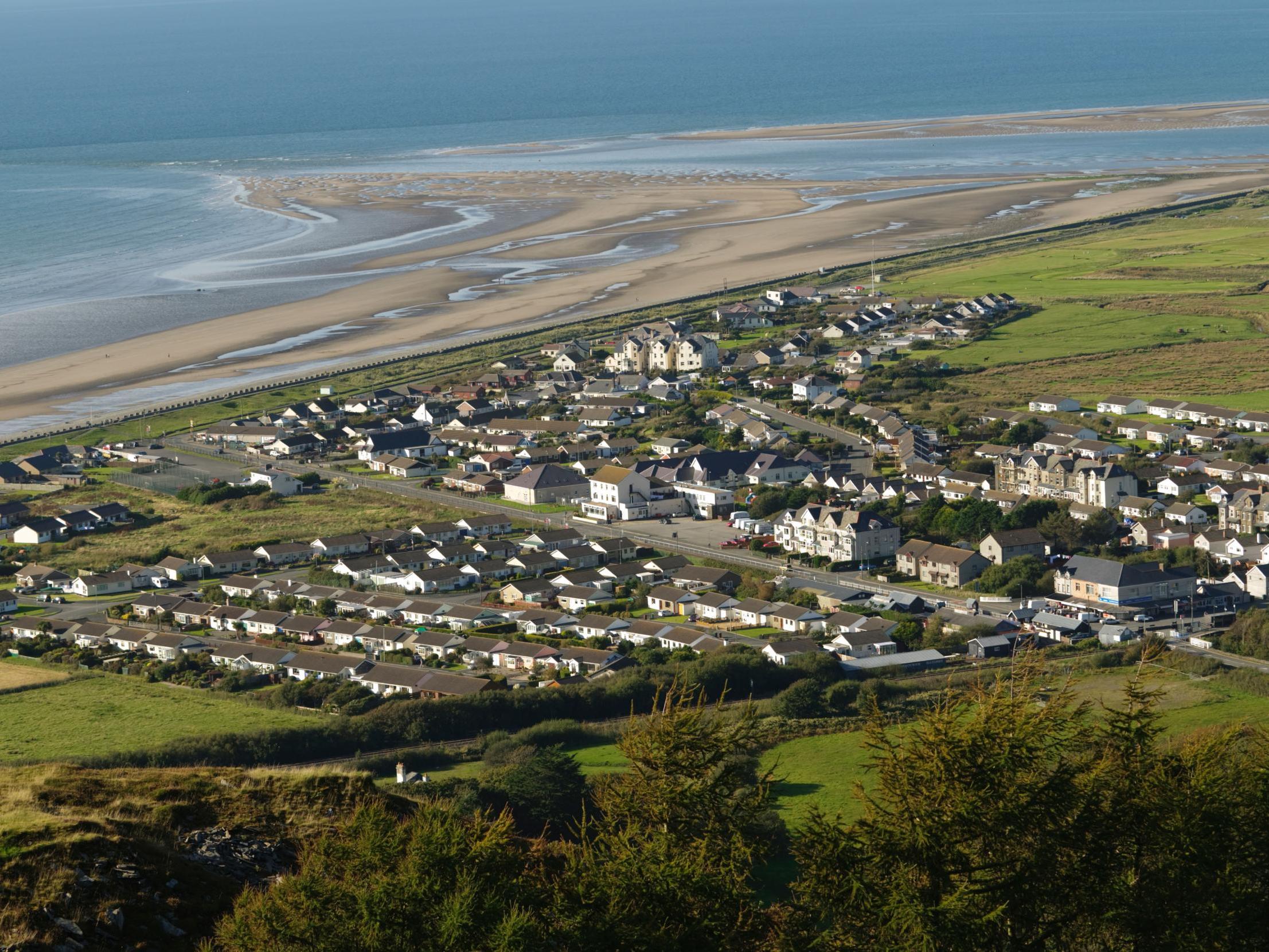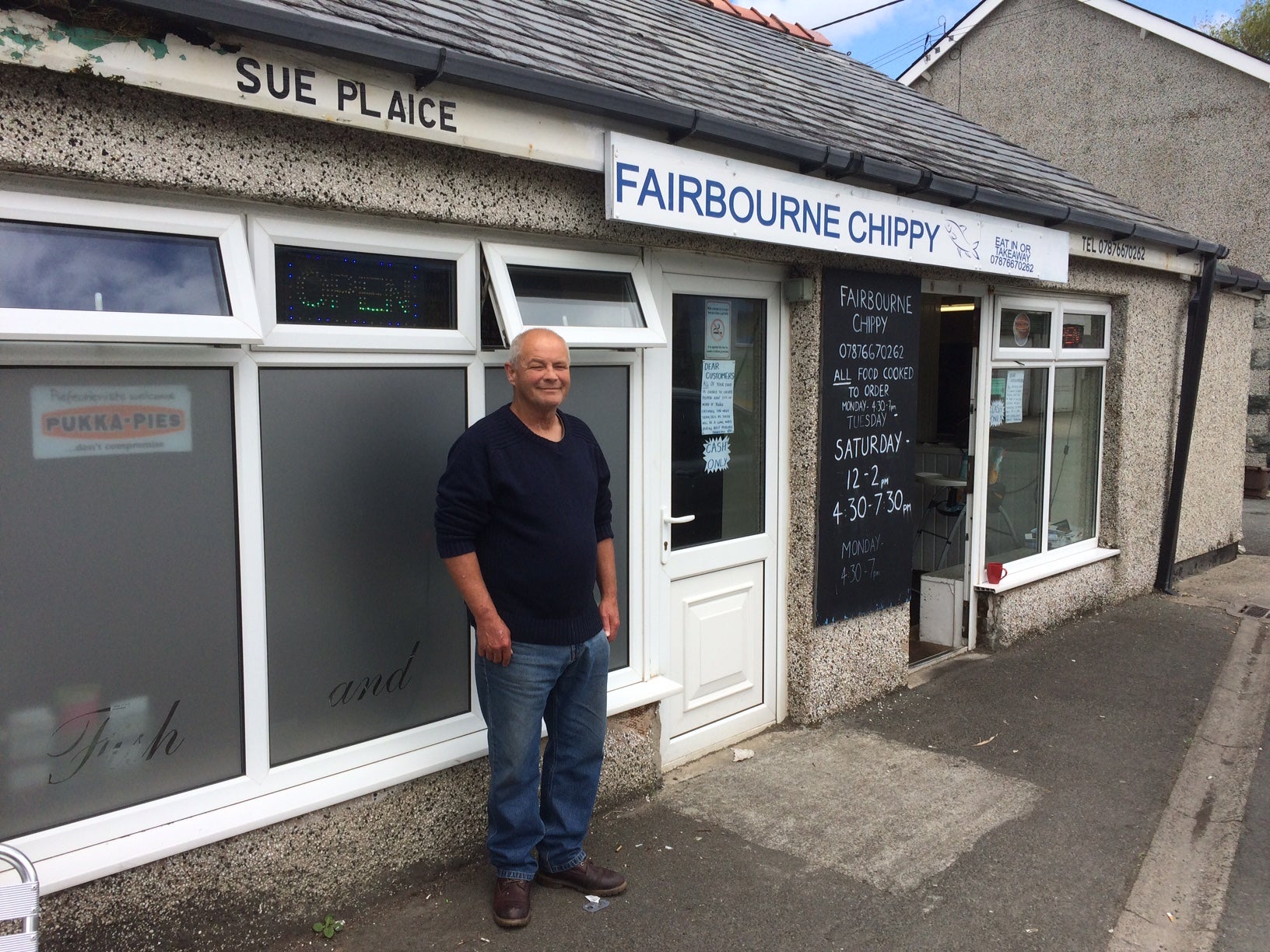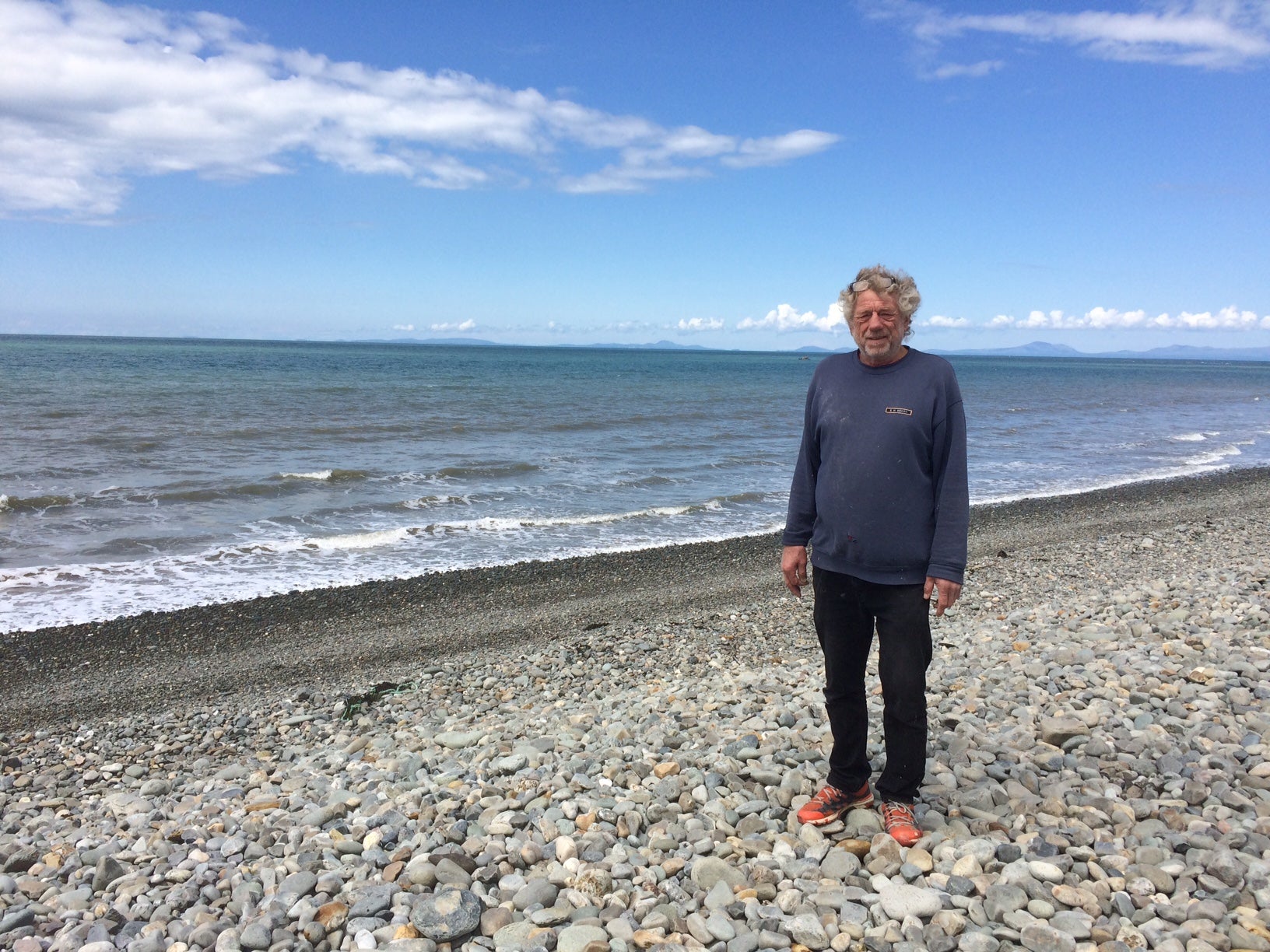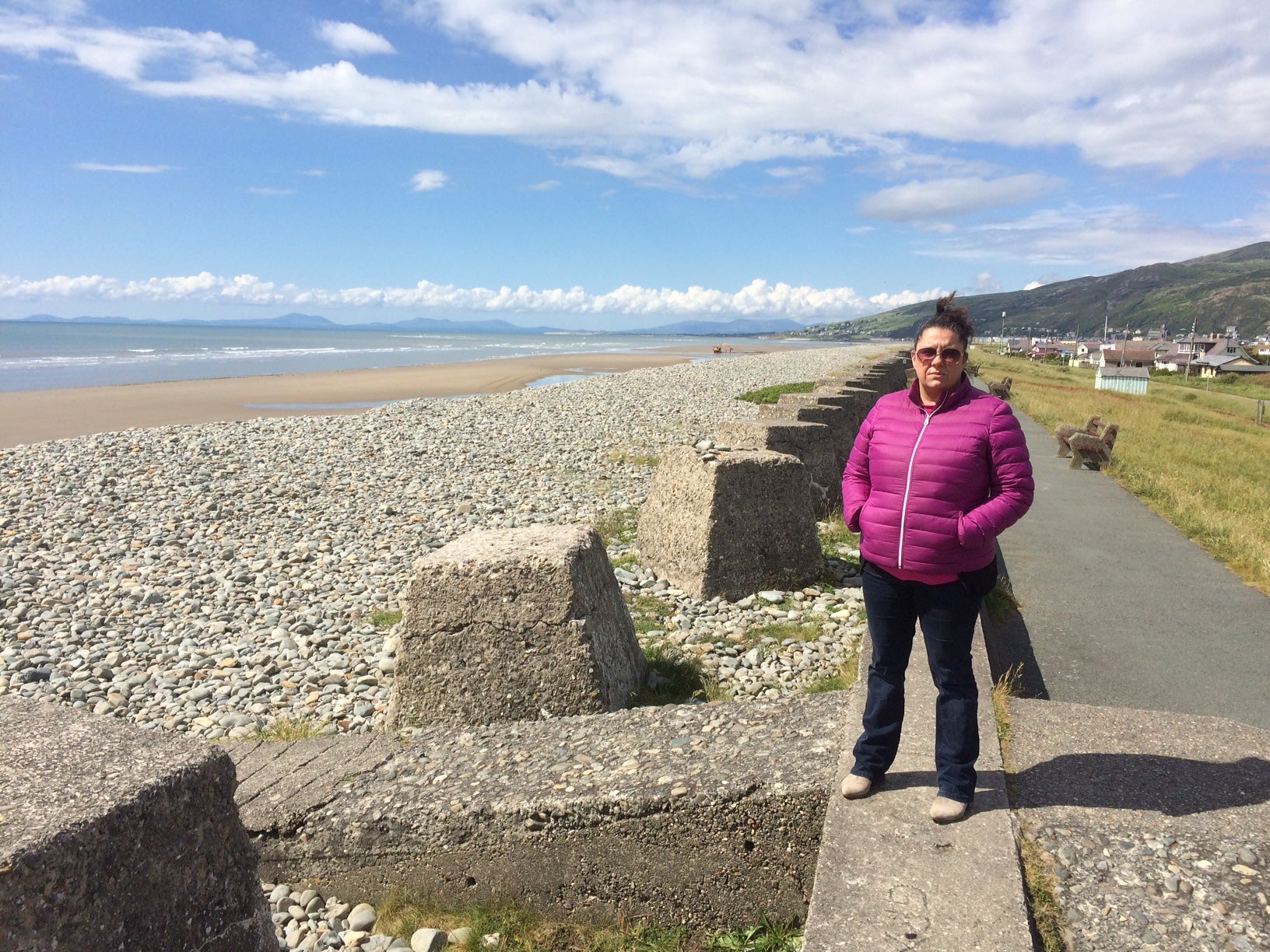The village that’s being surrendered to the sea
Rising sea levels could turn the families of Fairbourne into Britain’s first climate change refugees – though not everyone is willing to leave, reports Colin Drury


It is a coastal village which, on first impressions, seems the very definition of tranquillity. Fairbourne has a handful of shops, a couple of pubs and the air of peaceful contentment that perhaps comes with being gloriously sandwiched between the mountains and the sea. But today villagers in this west Wales idyll of just 400 homes are in mutinous mood.
“If they want us all out, they can expect a fight. What are they going to do? Bring in the army? There are only two ways in here, and they’re both easily blocked,” says Alan Jones, owner of the Fairbourne Chippy.
Such is the talk among the people who may soon take a much-unwanted title: the UK’s first climate change refugees.
Fairbourne’s location – essentially in a basin between Snowdonia, the Irish Sea and the Mawddach Estuary – has placed it under existential threat from global warming.
If sea levels continue to rise at present projections, experts have concluded it will become impossible to protect the village – firstly from flooding then, eventually, from complete submersion.
As a result, the local authority is set to take the remarkable decision of abandoning the place.
Under a “decommissioning masterplan” set to be partially unveiled at a public meeting on 26 June, all villagers will be ordered out and all infrastructure dismantled. Homes, shops, roads and sewers – as well as the local golf club and a narrow gauge steam railway – will be ripped out and removed without trace before the sea is allowed to reclaim the land. Gwynedd Council officials say they want all this done by 2045.
It will be the first time anywhere in the developed world that an entire community has had to retreat inland because of global warming. This village will, to all intents and purposes, become the first place wiped off the western map by climate change.

Standing on Fairbourne’s sea wall, it is easy to see the village’s vulnerability.
The entire 800-strong community sits below the line of its coastal defence. Even a small breach of this shingle bank and concrete topping would likely send a wall of water cascading on to seafront bungalows.
Emergency planners have gamed out what would happen if such a break did occur. In the worst-case scenario – an unlikely but not inconceivable one-in-200-year storm – they say the results could be catastrophic. Entire buildings would be washed away. “If it came in quickly, you would be looking at fatalities. And not in small numbers. You’re talking dozens of deaths,” one official tells me.
It is, the local MP Liz Saville Roberts says later, something that “keeps me awake at night”.
The problem is, as sea levels rise, that sort of catastrophic breach becomes ever more likely from smaller storm surges. Crucially, because the village sits right beneath Snowdonia National Park, once the sea comes over the walls, it has nowhere to drain: the result would be an immediate short-term disaster and an indefinite long-term submersion.
By 2054, the council contends, the risk will be too large to be manageable. Anyone still living in Fairbourne would not only be putting their lives in peril but those of emergency workers too.
“This is not just an environmental crisis,” one, a 69-year-old, tells me, glumly. “It is a social and humanitarian one. It is a living nightmare.”
If we do not prepare for this, the impact will be far-reaching and potentially devastating
Climate change will increase sea levels by 90cm by 2100, according to the UN’s Intergovernmental Panel on Climate Change – a rise that would have catastrophic consequences for low-lying communities, particularly islands in the Pacific and Indian oceans.
The Marshall Islands – a group of 1,000 islands in Micronesia – could face evacuation of its 70,000 inhabitants, while Kiribati, the Maldives and Tuvalu are also predicted to be at greatest risk. As well land being lost to the ocean, increases in coastal flooding will lead to saltwater contaminating fresh-water supplies and making land infertile.
But while these far-flung places are set to be worst-affected, there are also an estimated 200 coastal communities around Britain that would be endangered too.
Low lying areas of East Anglia and Lincolnshire could be especially affected, as well as swathes of Humberside close to the Humber Estuary, part of the southwest – notably the Somerset Levels – and broad areas of west Wales.
All in all, as the government-appointed Committee on Climate Change reported in November, 1.5 million British homes will be at risk of flooding by 2080.
Nor is it just houses in peril. By the same year, 1,600km of major roads, 650km of railways and 92 train stations will be in regular danger. Power stations, gas terminals and landfill sites, as well as tourism hotspots, have all been established on coastal land which will soon be under threat.
90cm
Projected sea level rise by 2100
“As a country we are only just starting to accept the unprecedented disruption we face,” says Dr Natasha Barlow, associate professor with Leeds University’s Priestley International Centre for Climate. “People think of this issue affecting far-off tropical islands. But we are an island, and, if we do not prepare, the impact will be far-reaching and potentially devastating.”
The effects will not just be felt by coastal communities either. Infrastructure disruption, internal migration and changing weather patterns will mean rising seas will impact on even the most inland of villages, towns and cities. “Dealing with this and addressing these issues must become a new norm,” Dr Barlow adds.
What happens in Fairbourne, in short, will soon be happening elsewhere in the UK.
In his fish and chip shop today, however, Alan Jones remains semi-sceptical, semi-defiant.
“They can’t predict the weather two days in advance half the time,” he says. “So how are they telling me they know what’s going to happen in 30 years?”
The 62-year-old moved to Fairbourne with his family from Wolverhampton in 2003 after falling in love with the village during summer holidays here. “It’s the kind of place you can leave your door unlocked,” he says. “It’s so friendly. It can take 20 minutes to walk up the street because you end up chatting with everyone you see.”
Until I need a rubber dinghy to get out my front door, I would rather not go anywhere
He refuses to believe the risk is as severe as Gwynedd Council makes out. “By coming out with this, they are blighting us for no good reason.”
His daughter, Laura, 26, who also works in the chippy, is more pragmatic. “I’m not sure what I’ll do [if I have to leave],” she shrugs. “You can’t fight nature, I guess.”
Much of the village seems to fall somewhere between these two poles: scepticism and fury on the one hand, gallows humour and acceptance on the other.
“I don’t say the sea isn’t rising,” 72-year-old Alan White tells me. “But, until I need a rubber dinghy to get out my front door, I’d rather not go anywhere.”
Is he angry? “We’re disillusioned,” he says. “You lose peace of mind because of the uncertainty.”
Many residents have seen house prices plummet since decommissioning was first mooted in 2014. A bungalow which went on the market three months ago for £175,000 is still available for purchase today. Only now at £135,000.
Banks, for the main part, have stopped offering mortgages. It’s a cash-buyer’s paradise. Although anyone investing and hoping to extend their new property could be in for disappointment. The council’s planning board, it is said, are now refusing permission for any extensions that include extra bedrooms.
“They don’t want any more people here,” says Stuart Eves. “What they are doing is winding the village down. They are creating instability so people leave, even if that means going into negative equity or losing life savings. No one knows for certain what will happen with the sea but the council is killing the place off anyway.”
Stuart himself is a growling teddy bear of a bloke who runs a 40-plot caravan and camp site here, and is chairman of the Arthog Community Council which is campaigning against the decommissioning.

The grandfather-of-six moved here from Buckinghamshire in the Seventies, and had expected to live out his days in what he calls “a land that time forgot”.
During an afternoon showing me the sights (train, beach, pub), he talks about the village’s Victorian origins – it was founded as a resort by an English flour merchant – and says he finds it impossible to believe it could be swallowed by the sea. Like many villagers, he thinks officials are overreacting.
There are plenty of scientists out there who don’t agree with the data that Gwynedd Council is using,” he says. “So, let’s monitor what’s happening for the next few years before we do anything drastic. Let’s wait and see.”
Sat in the whitewashed village hall, Lisa Goodier, Gwynedd Council’s senior project manager for flood and coastal erosion risk management, appears cheerful but troubled.
As the official tasked with drawing up the decommissioning strategy, she has found herself between the devil and, quite literally, the deep blue sea.
“We get criticised by the community: ‘why can’t you leave us until you know?’” she says. “Well, we can’t not plan because if something happened, they would ask, why didn’t you warn us?”
Lisa, who herself lives by the sea in Penmaenmawr on the other side of the national park, talks with authority and is clearly passionate about solving what she calls a “slow-moving emergency”. But occasionally she falters. “None us are going to come out of this well,” she says at one point. “We’re just trying to find a solution we can all live with.”
Decommissioning itself was first raised as a possibility in the years following a 2013 Shoreline Management Plan.
That report – built on projections from the IPCC – indicated 35 areas in this part of Wales were vulnerable to future flooding. But it was Fairbourne’s unique geography that raised particular concerns. A rising sea here would cause a cascading problem. Which is to say that not only does flooding from the sea itself become more likely but, conversely, from the hills too: as rainwater runs off Snowdonia into a higher sea, it would back up – right into the village. Fairbourne, in essence, would become a deep flood plain.
Alarmed by these findings, officials looked at potential solutions. In 2014, following minor flooding of the village, it was revealed the favoured option was decommissioning. A semi-official consultation has been taking place since.
“People say Fairbourne is being sacrificed so we can spend money defending other places,” says Lisa. “You could have all the money in the world and you still wouldn’t be able to make Fairbourne safe. We cannot engineer our way out of this.”
To be absolutely secure against flooding, the council contends, a barrier of at least four metres would be needed on top of current sea defences (themselves upgraded in 2013 at a cost of £6.8m). “Forget how much that would cost,” says Lisa. “You just cannot have a village sitting beneath a wall which has a sea knocking on the other side of it.”

Other blue-sky solutions have been considered and dismissed as unfeasible. This part of Wales will not see houses lifted onto girders; nor will people be allowed to stay living there as long as they have a boat and pilot’s licence – something done in flood risk areas of the Netherlands.
All of which means, I suggest, decommissioning appears not so much in consultancy as already decided on.
“We say it’s likely,” says Lisa. “But there are no other options at the moment.”
The main question from here, perhaps, is how exactly one goes about relocating an entire community which, in many cases, as no desire to leave.
Conversations are already being had about where people might be happy to move, and if they would like to do so en masse.
But will the council buy the homes they are forcing residents to give up? Will it protect villagers from losing life savings tied up in suddenly worthless properties?
“If people are compensated for what they are going to be losing, then that would be a mechanism to help us,” nods Lisa. “But, unfortunately, there isn’t any available at the moment, and I don’t know if there will be.”
The trouble is the sort of money required for evacuating a village – dispersing and then rehousing 800 people before dismantling all infrastructure – will run into hundreds of millions of pounds.
Coming on the back of a decade of austerity, Gwynedd Council doesn’t appear sure it can even afford such an operation – yet neither the Welsh nor British governments appear willing to foot the bill.
Westminster say this is a devolved matter for Cardiff. Cardiff has indicated climate change is a UK-wide issue which needs a specialised budget. Natural Resources Wales, the agency which looks after Welsh coasts, has no remit to move people. And even the Welsh flooding minister, Lesley Griffiths, has said her department has no obligation or budget to support those displaced.
One scheme proposed by Lisa – and popular with villagers – would have seen homes in Fairbourne bought by the council and rented back to residents until they had to move. But it has faltered amid lack of financing.
“We are falling between the cracks,” says MP Liz Saville Roberts over tea outside the village deli. “This needs to be a wake-up call for the whole country. Current ways of working in government don’t factor in the needs caused by climate change emergencies.
“But this is only going to be happening more so there needs to be a coherent overall strategy. Let’s be positive: Fairbourne could be a guinea pig for how, as a country, we deal with this properly and humanely. But at the moment that’s not yet happening.”
It is a cry for help that experts echo.
The Environment Agency – which has a remit that covers only England – officially warned just last month that new ways of coping with the oncoming environmental changes were needed.
In its new Flood and Coastal Erosion Risk Management Strategy, it said communities could not build and barrier their way out of problems caused by rising seas. The report called for a national discussion on how best to create resilience. It suggested limiting new coastal building and indicated some communities could be transformed so they can absorb occasional floods. It explicitly admitted that not everywhere could be protected as shorelines changed – although it did not name particular places.
“We need to act now without delay,” it said. “We need to apply a different philosophy.”
Yet, crucially, this government body offered no proposals for increased funding and provided no mention of how people losing homes should be helped. Neither did the Welsh government when asked for this article.
“We work hand in hand with local authorities to provide support for community schemes which reduce risk,” a spokesperson said. “But we do not provide individual grants to homeowners.”
Another crack, it seems, for the issue to fall down.
Back in Fairbourne, at the caravan site he started from scratch 43 years ago, Stuart Eves considers the whole sorry predicament.
All the villagers want, he says is a sense of security returned.
“We’ve had this hanging over us for too long,” he tells me. “Perhaps people making these decisions are doing their best but I think they forget real people’s lives are at stake. Fear of climate change may be causing this but it is the mishandling that is making it worse.”
Join our commenting forum
Join thought-provoking conversations, follow other Independent readers and see their replies
Comments